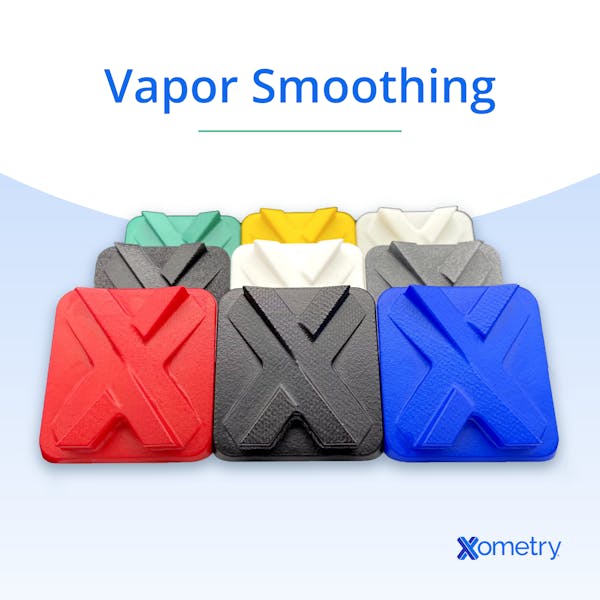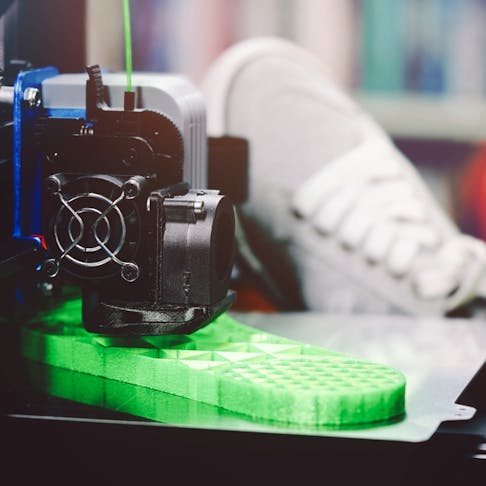Vapor smoothing is a low-labor post-processing technique for PETG parts that can produce a moderate to high surface gloss and significantly improve smoothness. The process works by exposing the printed part to a controlled, solvent-rich atmosphere. The solvent partially dissolves the outermost polymer layer, allowing the surface to flow and fill in microscopic valleys. Once the solvent evaporates, the re-solidified surface forms a continuous, glossy film.
This method can yield aesthetically appealing prototypes and improve the tactile feel of parts. However, it may reduce surface dimensional accuracy and obscure fine details due to the material flow during smoothing. Vapor smoothing is particularly useful for producing cosmetic prototypes that require a polished appearance, and for sealing porous parts produced by FDM (Fused Deposition Modeling) or FFF (Fused Filament Fabrication) into watertight or even airtight components. PETG is resistant to many common solvents, so only certain chemicals, such as dichloromethane or tetrahydrofuran, are effective, and they must be handled under strict safety protocols due to their toxicity and volatility.
This article will explain the vapor smoothing process for PETG, describe the underlying material science, and discuss the benefits, limitations, and safety considerations.
What Is Vapor Smoothing PETG?
Vapor smoothing PETG refers to the post-processing technique used to improve the surface irregularity of 3D-printed parts made from polyethylene terephthalate glycol (PETG) filament or powder. These parts are usually made using FDM, FFF, and the various methods of PBF (powder bed fusion, sometimes SLM (selective laser melting)). These processes tend to build resolution, resulting in visible Z-axis steps that mar the surface.
Vapor smoothing is a method most commonly used with ABS (acrylonitrile butadiene styrene) prints, but it is increasingly applied to PETG. However, it's important to note that vapor smoothing PETG may not yield the same results as ABS. It might not also be as effective in achieving a glossy finish due to the differences in material properties. PETG is more resistant to commonly used solvents, so the effect is reduced compared to its application to ABS.
What Is Vapor Smoothing PETG Also Known As?
In most material applications, vapor smoothing is also known as chemical smoothing, acetone smoothing, and chemical vapor smoothing.
What Is the Purpose of Vapor Smoothing PETG in Manufacturing?
The purpose of vapor smoothing is to partially liquefy the surface of a 3D-printed part through controlled solvent exposure. This softens the outermost material, allowing adjacent layers to blur and merge. The result is a surface with reduced layer-step discontinuities, creating a smoother and more uniform appearance.
In manufacturing, this process serves three primary purposes. First, it enhances surface adhesion at the outer skin, effectively sealing pores and closing small gaps between extruded filaments. Second, it delivers a cosmetic improvement, as visible layer lines diminish and a glossy finish can often be achieved. Third, when performed under controlled conditions, vapor smoothing does not significantly weaken the original interlayer bonds (Z-direction strength) because the solvent penetration is limited to the surface rather than affecting the bulk of the material.
What Are the Industries That Use Vapor Smoothing PETG?
Various industry sectors employ vapor smoothing techniques for 3D-printed parts, including PETG, such as the automotive, consumer goods, and medical sectors. Vapor smoothing can improve the surface finish of specific automotive components, improve non-precision parts such as soft or bone tissue models used for surgical planning, and improve consumer product cosmetic parts, such as electronics casings and fashion accessories.
Vapor smoothing with PETG is not as widespread as with other materials like ABS. PETG is chosen for its specific properties, such as toughness and transparency. Sometimes, its natural surface finish is preferred for specific applications. It is important to note that the vapor smoothing process requires very aggressive and harmful solvents, reducing the technique's applicability.
How Does Vapor Smoothing PETG Work?
Vapor smoothing of PETG works by suspending the printed part in a controlled solvent vapor atmosphere. As solvent vapors condense onto the surface, they soften the polymer matrix by temporarily weakening intermolecular bonds between polymer chains, without causing significant depolymerization or chemical breakdown. This controlled surface dissolution allows material from adjacent print layers in the Z direction to partially flow and merge, reducing the sharp boundaries between them. As the solvent evaporates, the softened polymer re-solidifies, forming a more continuous and uniform surface layer. The final result is a part with an aesthetically smoother finish and reduced surface roughness.
Vapor smoothing can also seal porosity, improving water resistance and, in some cases, airtightness. Additionally, by reducing the severity of layer-step interfaces, vapor smoothing may offer a modest improvement in the anisotropic mechanical properties of FDM/FFF-printed PETG parts. However, this effect is generally secondary to the cosmetic and sealing benefits.
What Is the Step-by-Step Process of Vapor Smoothing PETG?
Listed below is the general process of vapor smoothing PETG:
1. Gather the Necessary Materials
The primary material needed for vapor smoothing is a chemical solvent that can dissolve the outer layer of the 3D-printed part, effectively smoothing the surface. For PETG, solvents like ethyl acetate, MEK, or dichloromethane are required. Prepare a gas-tight and solvent-resistant container (the vapor chamber) large enough to hold the 3D-printed part and the vaporizing solvent. A support or rack to suspend the 3D-printed part inside the container will also be needed. Additionally, prepare all safety equipment such as PPE and fire extinguishers.
2. Prepare the Part
Most of the preparatory steps before vapor smoothing are simply those of post-print model completion. This includes removing any supports or soluble support material residues. Clean up any support blemishes that are part of the printed part. Fit the hanging support to the part to minimize scarring from support contact during vapor smoothing, ensuring the model's utility is not compromised. Finally, suspend the model in the vapor chamber.
3. Safety Precautions
Various safety precautions should be followed, such as ensuring the space is well-ventilated, having a carbon filter VOC respirator available, and using it when handling the solvent or vapor-smoothing parts. On completion, use a forced vent to clear the chamber, then pass the air through an activated charcoal filter and outside. Use solvent-resilient gloves (latex, for example) when handling the solvent. Have a fire extinguisher on hand and leave post-smoothing parts suspended in a well-ventilated space to finish the solvent evaporation process.
4. Preheat the Container (Optional)
Preheat the vapor chamber to an appropriate temperature, based on experience and tests. Don’t exceed a safe level (below 70 °C) to avoid the risk of bubbles developing on the prototype. Ideally, the chamber should be maintained at your target temperature for the period of the process. And if possible, this temperature and the timing of the process should be automated, for maximum consistency.
5. Vapor Exposure
The duration and intensity of the vapor exposure are highly dependent on print material, model geometry, solvent type, solvent heating, and your experimental evaluations. The critical time/intensity required is sufficient to soften the surface without penetrating deeper into more vulnerable areas. The part should be left until a satisfactory degree of smoothing has been achieved. However, it should not be long enough to degrade model accuracy excessively or trigger distortion in vulnerable areas of the part.
6. Seal and Monitor the Chamber
The vapor chamber must be gas-tight during processing to contain solvent vapors and should include a venting system with activated charcoal filtration before release. Assume that the surrounding workspace may still accumulate volatile organic compounds (VOCs), as solvent vapors can impair the sense of smell, making exposure harder to detect.
While the chamber is sealed, closely monitor the smoothing process, particularly for new geometries or unfamiliar print settings. Thin walls, unsupported sections, and low-infill regions are especially vulnerable: softened material can distort, collapse, or allow solvent to penetrate more deeply. Such damage is irreversible, so exposure duration should be carefully controlled and observed to balance surface quality with part integrity.
7. Ventilation and Purging
When exposure is complete, purge the chamber through a filter system before opening. Assume the area immediately around the chamber is contaminated, as olfactory fatigue may prevent detecting solvent concentration.
8. Post-Exposure Evaporation
After smoothing, leave the part suspended in a ventilated area to allow residual solvent to evaporate completely. This prevents surface tackiness and ensures mechanical stability.
9. Post-Process Cleaning
Many parts will not require any cleaning after vapor smoothing if they went into the process contaminant-free and the process itself is clean. However, it's important to ensure all traces of solvent are evaporated using a post-vapor-smoothing stage. A simple wash with isopropyl alcohol and then a mild detergent solution, followed by a deionized water rinse and drying, will leave the models clean and ready to use.
10. Final Inspection
Vapor smoothing can result in loss of detail, distortion, and other imperfections, so it is worthwhile to thoroughly examine and check for excessive dimensional changes, loss of symmetry, warping, etc., before passing parts as complete and ready for use.
What Are Some Common Post-Processing Methods for Metal Parts?
Listed below are some standard post-processing methods for metal parts:
1. Electrochemical Polishing
Electrochemical polishing (or anodic polishing, electrolytic polishing, or electropolishing) places the metal part as the anode in an electrolytic cell. It uses an ionization current to erode a thin and very controlled surface layer from the part. There is a strong tendency for peaks and high points on a surface to react more vigorously with the electrolytic process. High points are removed more aggressively than low points or flat surfaces. This results in significant improvement in the surface finish, such that porosity-free prototypes can get close to a mirror finish with enough time.
2. Mechanical Polishing
The traditional method for improving surface finish on metals is to abrade the surface with increasingly fine-grained ablation materials. This ends with a polish process that uses an abrasive so fine it leaves no eye-detectable irregularities. This process is as old as metallurgy and was used in the ancient world to give items an appealing appearance. For example, surfaces with silver or copper mirroring give high-status weapons an impressive finish.
In a modern context, much of the same can be achieved by progressively decreasing the grain size of abrasives used in a barrelling process or mechanical/hand polishing. This is a time-consuming and generally expensive process. It is rarely used in mass production but may apply to prototypes, for which cost is seldom a primary driver. However, irregular and complex parts do not lend themselves to this.
3. Chemical Polishing
Chemical polishing relates closely to electrochemical polishing, lacking only the ionization current. It is performed using proprietary blends of phosphoric, nitric, sulfuric, and hydrochloric acids, combined with stabilizers and surfactants to deliver smooth surfaces. Chemical polishing can be fast, but it is only suitable for modifying relatively smooth surfaces, as there is less tendency for “high point” removal than in electrolytic processes.
How Much Does Vapor Smoothing PETG Cost?
The cost of vapor smoothing PETG varies significantly depending on whether it is performed in-house or outsourced as a service. As a service, specialist providers who perform vapor smoothing at scale typically charge about 5-15% of the original print cost. Providers with less experience or lower process volume may have more variable pricing structures, ranging from no additional charge (included in a finishing package) to a cost comparable to the original prototype.
For organizations considering in-house capability, entry-level trials can be performed at low cost with improvised equipment, but this approach typically lacks consistency and safety controls. Establishing a safe, repeatable, and production-grade setup requires investment in solvent-resistant chambers, ventilation and filtration systems, monitoring equipment, and operator safety protocols. Capital costs for such systems can range from $30,000 to $60,000 or more, depending on automation, throughput, and safety standards.
How Does Laser Beam Profiling Optimize PETG Part Vapor Smoothing?
Analyzing the laser beam profile ensures that the energy is evenly distributed across the PETG surface. Uniform energy distribution results in a more consistent surface finish. Resolution depends on spot size, so a better quality laser and better optics will allow higher resolution outcomes in print. Better energy distribution results in more uniform heat application when fusing the powder and a lower risk of localized heat damage that can mar the surface finish.
For more information, see our Laser Beam Profiler guide.
What Are Examples of Vapor Smoothing PETG Products?
Some examples of vapor-smoothed PETG products are:
1. Prototypes and Functional Parts
Vapor smoothing is used for prototypes every day, especially if cosmetic quality is more important than precision. Functional prototypes often have a second life as market test products, investor relations tools, and advertising media. To that end, vapor smoothing can be a beneficial process in delivering multi-task, capable 3D-printed product outcomes.
2. Decorative Objects
When a 3D print is produced for a decorative purpose, the as-printed state generally fails to meet the desired aesthetic standards. FDM/FFF parts are low resolution and really look like prototypes. Vapor smoothing can transform the appearance of parts from striated and prototype-like to presentable, requiring minimal effort and labor. Alternatives such as filling/sanding are labor-intensive and require skilled work. These parts' intrinsic porosity and low resolution in their unsmoothed state are cosmetically poor.
PBF parts have a rough, particulate finish that is not considered highly cosmetic. However, their resolution is much better than typical FDM/FFF, and their porosity is approximately zero. On that basis, vapor smoothing can lift these parts from “functional but ugly” to excellent, by minimizing the sandy nature of the surface and rendering it glossy.
3. Cosplay Props and Costumes
Stage, movie, and cosplay equipment are sometimes produced by 3D printing and often include painted and plated finishes to meet color expectations. This requires smoothing that doesn’t double or triple the cost of parts. Similarly, the increasing prevalence of home 3D printing is leading to growth in vapor smoothing as a do-it-yourself process.
4. Display Models and Miniatures
Display models and miniatures tend to be small and intricately detailed. Vapor-smoothing PETG-printed materials help make them more visually pleasing.

What Is the Life Span of Vapor Smoothing PETG Products?
The useful functional life of a PETG prototype ends when it is broken by excessive force in use, abraded to the point of damage, or crushed. In general, PETG prototypes do not have an intrinsic life span, in that the material is extremely stable and hard to degrade by any non-aggressive means. For example, exposure to the types of solvents used in vapor smoothing does not happen in everyday environments. The temperature required to damage a PETG printed part is very high, which is not present in everyday environments. Additionally, PETG is non-hygroscopic and essentially impervious to microbial or bacterial attack.
What Is the Quality of Vapor Smoothing PETG Products?
When carefully performed, vapor smoothing of PETG parts can produce a significant quality improvement in 3D-printed parts.
Does Vapor Smoothing Affect PETG Part Surface Smoothness and Uniformity?
It depends. Vapor smoothing allows microscopic surface features, up to the resolution of the build, to dissolve into a single, continuous film and then harden as the solvent evaporates. The final result is generally a moderate- to high-gloss surface which no longer shows the build-related surface texture that results from the printing. For lower Z resolution processes such as FDM/FFF, the surface will be considerably smoothed. However, it may show signs of the Z steps, where curvature emphasizes those steps by a disjointed flat surface that appears as aliasing on the curvature. These features will be smoothed but not removed. Where the build features and resolution are higher, such as in PBF models, vapor smoothing can reliably remove virtually all signs of the build steps and powder texture. The smoothness and uniformity of the surface will be improved, and porous prototypes can be relied on to be waterproof in most cases, after smoothing.
Frequently Asked Questions About Vapor Smoothing PETG
What Is the Difference Between Vapor Smoothing PETG and Acetone Vapor Smoothing?
PETG is not soluble in acetone, so considerably more aggressive solvents such as MEK are required. Acetone vapor smoothing is appropriate for ABS and polystyrene prototypes, as well as other materials. In all other regards, the processes are essentially identical. If the equipment is wisely selected, both methods can be implemented in the same system, though not simultaneously.
What Is the Difference Between Vapor Smoothing PETG and Vapor Smoothing PLA?
Smoothing of PETG is usually performed with MEK, toluene, chloroform, cyclohexanone, or dichloromethane, whereas PLA (polylactic acid) reportedly responds best to dichloromethane only. Otherwise, the process equipment is interchangeable, and the methods are identical.
For more information, see our guide on Vapor Smoothing PLA.
Summary
This article presented vapor smoothing PETG, explained it, and discussed it works and its advantages. To learn more about vapor smoothing PETG, contact a Xometry representative.
Xometry provides a wide range of manufacturing capabilities, including 3D printing and other value-added services for all of your prototyping and production needs. Visit our website to learn more or to request a free, no-obligation quote.
Disclaimer
The content appearing on this webpage is for informational purposes only. Xometry makes no representation or warranty of any kind, be it expressed or implied, as to the accuracy, completeness, or validity of the information. Any performance parameters, geometric tolerances, specific design features, quality and types of materials, or processes should not be inferred to represent what will be delivered by third-party suppliers or manufacturers through Xometry’s network. Buyers seeking quotes for parts are responsible for defining the specific requirements for those parts. Please refer to our terms and conditions for more information.


